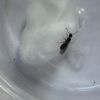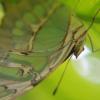Hi
Hoping for help with a species identification. Had a nuptial flight of small( queens are 5mm) ants today in Victoria BC. Founds them inside and outside window and paver driveway. See details and pic below. Tried best for a good pic but they are very small and were moving a lot under the disection microscope we have. We ended up with 10 and will be setting up in test tubes. Excited as this is the first hear hunting for ants and the second species so far this year.
1.Location of collection: Victoria, BC, Canada.
2. Date of collection: June 4th,
3. Habitat of collection: Sunny day 19-22 degree Celsius. Inside and outside windows.Paver driveway. 30% Humidity
4. Length (from head to gaster):5mm length for winged queens. Workers aprox 1.5mm
5. Color, hue, pattern and texture: All black body. 5mm, winged.
6. Distinguishing characteristics: None
7. Distinguishing behavior: All have wings attached, some with only 1 wing. Apear to come from nest under pavers.
8. Nest description: Between sidewalk, and paver driveway.
Thank You
Russell

















